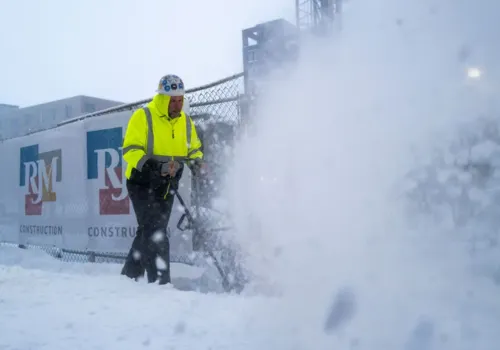
With much of the U.S. grappling with frigid temperatures this week, contractors are making sure their workers stay safe in the face of extreme cold. A significant snowstorm struck the Gulf Coast, while much of the East experienced dangerously low temperatures. These conditions create added risks for construction workers, especially in regions that are unaccustomed to such cold.
“When you think about how heat affects [workers] based on what they’re used to, like someone who works in an environment that’s always hot, they’re going to be more accustomed to the heat,” said Jessica Bunting, director of research for CPWR — the Center for Construction Research and Training. “It can be similar with the cold. Not only are our bodies more acclimated, but also we have better gear, better clothing.”
The extreme cold has become more common in regions previously unfamiliar with freezing temperatures. In February 2021, temperatures in Dallas-Fort Worth dropped to 2 degrees below zero, sparking an energy crisis. In 2022, much of Texas faced below-freezing temperatures over the holidays. These unusual cold spells contrast with the higher-than-usual summer temperatures that have also been on the rise. Experts say that climate change plays a key role in these extreme weather shifts.

According to safety experts, managing cold weather on construction sites requires the same vigilance as managing heat. Jobsite superintendents and managers must have a safety plan, regularly observe workers, and provide training on new hazards.
Turner Construction, based in New York City, has experience with projects in various climates. The company is currently working on the Buffalo Bills’ $1.4 billion stadium in Orchard Park, New York, a project subject to substantial snowfall.
“I think the biggest thing is just awareness and knowing that you’re going to have winter weather issues,” said Steve Spaulding, environmental health and safety chief for Turner. Spaulding stresses the importance of planning—safety teams must know in advance when temperatures will drop and when snow or sleet is expected, so they can prepare the site and protect both materials and the workforce.
Todd Friis, senior vice president of risk management at Chicago-based Clayco, also emphasized the need for proactive planning. “Dealing with winter conditions requires proactive planning, which is why we develop detailed winter weather preparation plans well in advance of any anticipated extreme conditions,” Friis said. “These plans prioritize worker safety while maintaining efficient and effective construction progress.”
Cold stress and hypothermia can set in quickly, sometimes even before workers notice the symptoms. "Even on a frigid jobsite, employees still sweat, which in cold temperatures can be dangerous, as hypothermia sets in fast," said Mary Bauer, an OSHA compliance assistance specialist based in Wisconsin. Cold weather can also affect workers' judgment, leading them to take shortcuts or make risky decisions in an effort to find warmth.

While OSHA does not have a specific standard for cold weather safety, it does offer resources to help employers keep workers safe. Employers are responsible for ensuring a safe work environment, and if weather conditions interfere with worker safety, they must take action. “In OSHA’s eyes, everybody needs a safe and healthful workplace,” Bauer explained. “And if the weather, the climate, or something is interfering with that, the employer needs to make a change.”
Workers who aren’t accustomed to cold temperatures might not have proper gear, so employers should provide necessary cold-weather attire. Bauer said, “If you’re talking about the southern states having situations where they’re working in subfreezing, something below 30 degrees and they’re not used to it, they don’t own gloves, they don’t own jackets and the right type of shoes, the employer should be ensuring they have adequate protection before they go out.”
Experts recommend several strategies to help ensure worker safety in extreme cold:
Spaulding pointed out that resources for cold weather safety are plentiful, and industry leaders often collaborate to share best practices. “If you’re always thinking of the worker first, it makes it very easy,” Spaulding said.
By taking these precautions, contractors can ensure the safety of their workers during harsh winter weather, keeping jobsites secure even in the most extreme conditions.